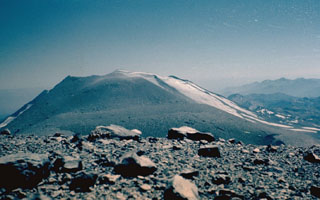Report on Nevados de Chillan (Chile) — 6 October-12 October 2021
Smithsonian Institution / US Geological Survey
Weekly Volcanic Activity Report, 6 October-12 October 2021
Managing Editor: Sally Sennert.
Please cite this report as:
Global Volcanism Program, 2021. Report on Nevados de Chillan (Chile) (Sennert, S, ed.). Weekly Volcanic Activity Report, 6 October-12 October 2021. Smithsonian Institution and US Geological Survey.
Nevados de Chillan
Chile
36.868°S, 71.378°W; summit elev. 3180 m
All times are local (unless otherwise noted)
SERNAGEOMIN reported continuing explosive and effusive activity at Nevados de Chillán’s Nicanor Crater during 16-30 September though weather conditions often prevented visual confirmation. Explosions generated plumes with low ash content that rose as high as 1.1 km above the crater rim. A new lava dome (Dome 3) in the crater was first identified on 15 September and was 27 x 40 m, elongated NW-SE, and 990 square meters in area. The dome formation was preceded by a decrease in the extrusion rates and temperatures of the L5 and L6 lava flows. By 24 September growth at Dome 3 reached 36 x 43 m and covered 2,137 square meters. Dome 4 was first visible on 29 September, adjacent to Dome 3 on the NE side, and produced a new lava flow (L7) that traveled 50 m down the flank between the L5 and L6 flows. The L5 lava flow also began to advance.
On 5 October the L5 and L7 lava flows advanced and nighttime incandescence from both flows increased. Incandescence from the crater was visible in webcam images at night during 8-9 October. On 9 October a long-period earthquake was recorded at 0706 on 9 October; an associated emission rose more than 240 m above the vent and drifted NW. The Alert Level remained at Yellow, the second lowest level on a four-color scale. ONEMI stated that Alert Level Yellow (the middle level on a three-color scale) remained in place for the communities of Pinto and Coihueco, noting that the public should stay at least 2 km away from the crater.
Geological Summary. The compound volcano of Nevados de Chillán is one of the most active of the Central Andes. Three late-Pleistocene to Holocene stratovolcanoes were constructed along a NNW-SSE line within three nested Pleistocene calderas, which produced ignimbrite sheets extending more than 100 km into the Central Depression of Chile. The dominantly andesitic Cerro Blanco (Volcán Nevado) stratovolcano is located at the NW end of the massif. Volcán Viejo (Volcán Chillán), which was the main active vent during the 17th-19th centuries, occupies the SE end. The Volcán Nuevo lava-dome complex formed during 1906-1945 on the NW flank of Viejo. The Volcán Arrau dome complex was then constructed on the SE side of Volcán Nuevo between 1973 and 1986, and eventually exceeded its height. Smaller domes or cones are present in the 5-km valley between the two major edifices.
Sources: Servicio Nacional de Geología y Minería (SERNAGEOMIN), Oficina Nacional de Emergencia-Ministerio del Interior (ONEMI)

